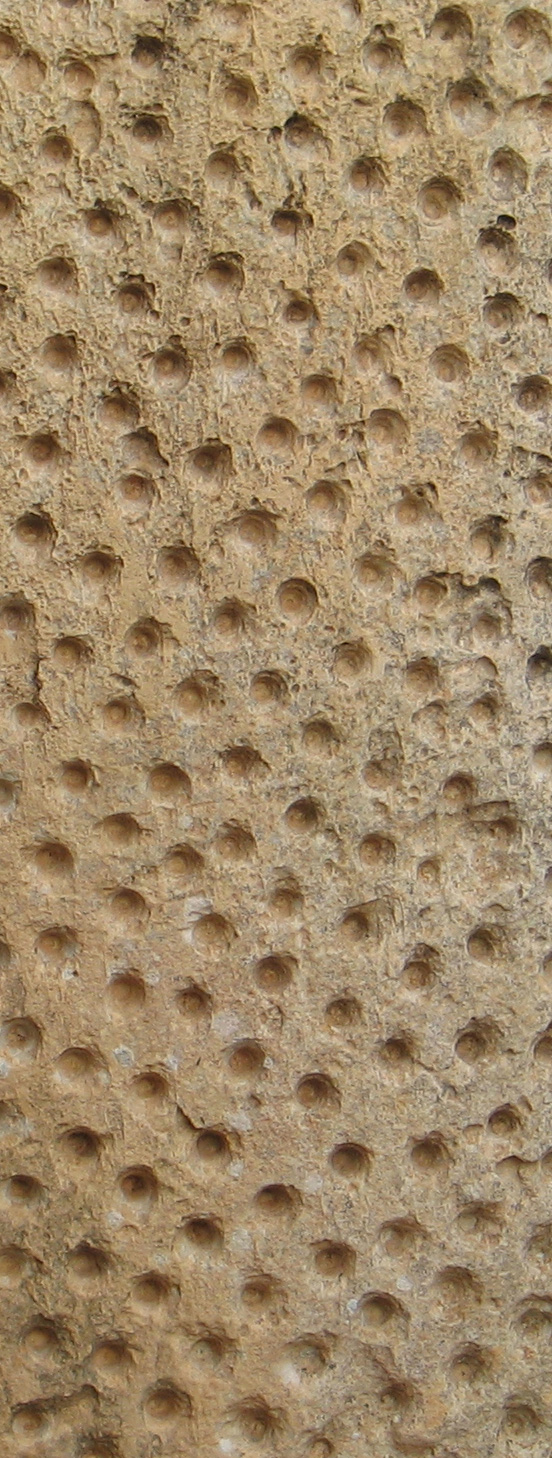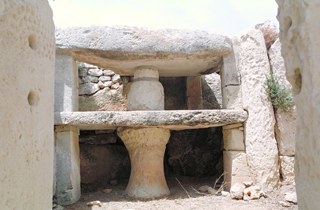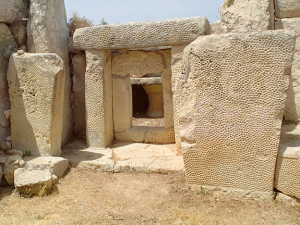
Pitted texture on limestone columns South Temple
The project originator Bernadette Flynn first visited Malta in 1997 after seeing photographs of the extraordinary stone buildings of the Malta islands. Drawn to learn more about these ancient sites she was able to visit the islands during a Sabbatical as a visiting scholar at Middlesex University’s media arts department in London. During this time she was interested in how the cultural heritage of the temples might be communicated using digital media.
At the time, the Mnajdra Temples were closed to the public due to damage caused by nearby quarrying. Upon request I was granted permission by the Museums Department to visit Mnajdra along with a number of other sites. Walking down from the Ħagar Qim temple 500 metres up the hill, I first noticed the small islet of Filfla out to sea across the low scrub landscape dotted with stone bird traps and then came upon Mnajdra nestled in a hollow. Aside from a lone guard in a distant shed, I was lucky enough to have the place all to myself. At the time there was no signage and little fencing to disturb the direct experience of the place. During the day I set up my equipment and took photographic panoramas of the semi-circular chambers in the lower, middle and East temples.
I was fascinated by the arrangement of semi-circular rooms and amazed that many of the doorways in the South temple still had lintels, large upright blocks and tiered wall structures. I wandered through larger chambers leading onto small enclosures and was intrigued by the ways that the site required different types of movement: crouching through doorways, stepping over sills and walking up stairs. I noted that many of the side chambers appeared to be hidden from direct view and only hinted at through wall openings and niches. Through the day the colour of the globigerina limestone changed from yellow to grey and mottled pink depending on the light and framed the landscape and the island from vantage points. The texture, similar to the Hawkesbury Sandstone that I love, had the patina of age often in wave-like forms, flaked and fashioned into sculptural indentations.
 After this first visit, Bernadette returned a number of times to photograph the smaller chambers at the site, to document the artefacts and to witness the temples in different seasons. At the autumn equinox in 2005 she photographed the rays of the dawn light moving through the main passageway of the South Temple to light up the altar in the inner chamber. Bernadette’s visit in 2006 also coincided with the Summer Solstice opening of the temples where the dawn light marks out the edge of the left hand pillar of the main temple block. She had the pleasure of attending workshops, participating in conferences about cultural heritage and meeting with local archaeologists and heritage experts.
After this first visit, Bernadette returned a number of times to photograph the smaller chambers at the site, to document the artefacts and to witness the temples in different seasons. At the autumn equinox in 2005 she photographed the rays of the dawn light moving through the main passageway of the South Temple to light up the altar in the inner chamber. Bernadette’s visit in 2006 also coincided with the Summer Solstice opening of the temples where the dawn light marks out the edge of the left hand pillar of the main temple block. She had the pleasure of attending workshops, participating in conferences about cultural heritage and meeting with local archaeologists and heritage experts.
Returning to her studio in Brisbane in Australia, Bernadette explored different types of interactive media to provide visitors with an experience of the temple environment and spaces. Her interests in large-scale panoramic visualisation and visitor immersion lead to working with the Advanced Visualisation and Interaction Environment (AVIE) at the iCinema, Centre for Interactive Cinema Research, University of NSW, Sydney where she produced Spaces of Mnajdra for her PhD research.

